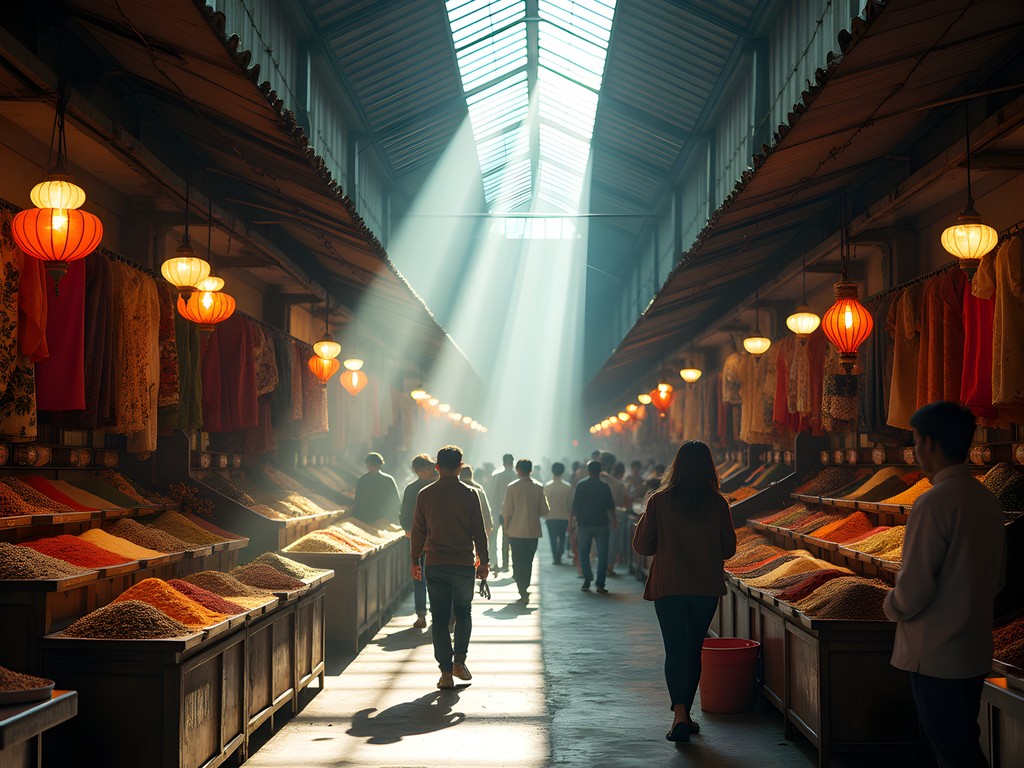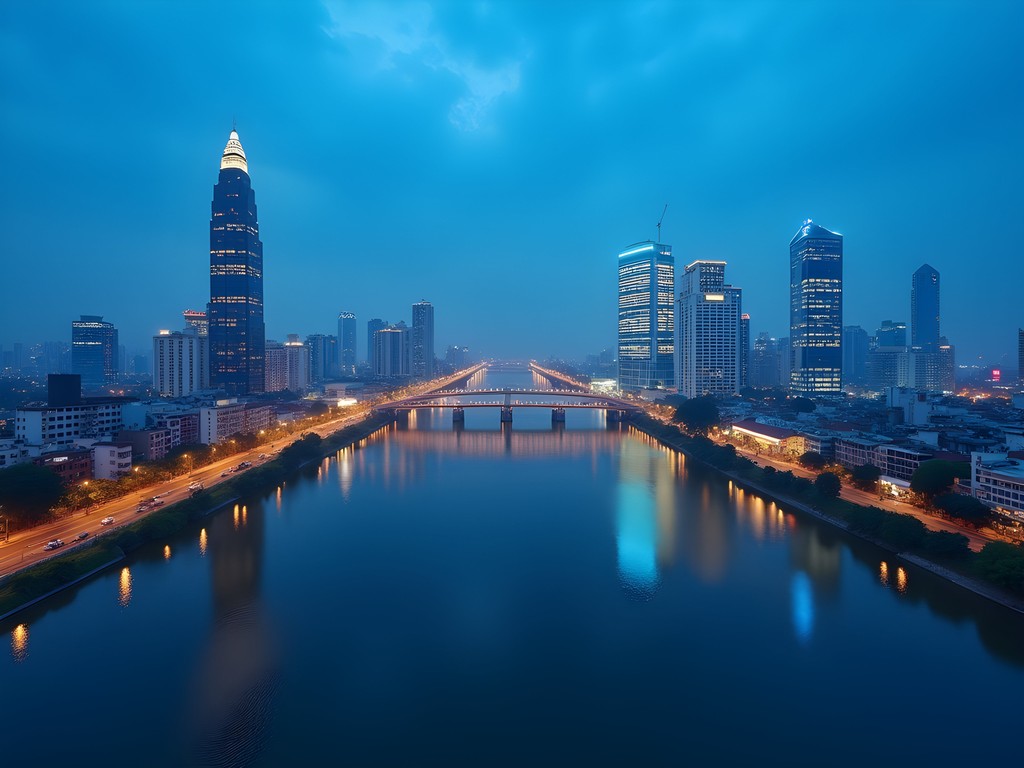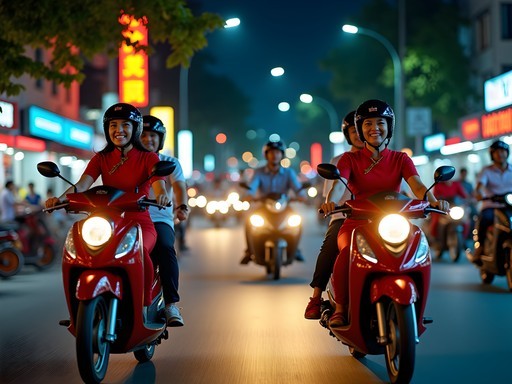Disclosure: This article contains affiliate links. We may earn a commission from purchases at no extra cost to you, which helps our travel content.
As an electrical engineer who's spent years documenting the intersection of tradition and technology across continents, Ho Chi Minh City presented me with a photographer's paradise of contrasts. The city operates like a complex circuit board – chaotic yet perfectly functional, with layers of history and modernity existing in remarkable equilibrium. After spending a week navigating its pulsing streets during the dry season, I've compiled this technical yet approachable guide for fellow photographers looking to capture HCMC's distinctive urban rhythm and hidden visual treasures.
Essential Gear for HCMC's Challenging Light Conditions
The lighting conditions in Ho Chi Minh City present a fascinating technical challenge that reminds me of designing variable load electrical systems. From the harsh midday sun creating extreme contrast to the neon-saturated nights, your gear needs to handle significant dynamic range.
A versatile zoom lens is your best companion – I relied heavily on my 24-70mm for everything from street scenes to architectural details. For those magical golden hour shoots along the Saigon River or from rooftop bars, a polarizing filter is non-negotiable to manage reflections and enhance colors. The city's humidity can be brutal on equipment, so I always carry a silica gel packets in my camera bag to combat moisture.
When shooting in bustling markets like Bến Thành or Bình Tây, where light conditions change dramatically as you move from outdoor stalls to covered sections, a light meter proved invaluable for quickly adjusting settings. For night photography along Nguyễn Huệ Walking Street or capturing the traffic light trails, a compact but sturdy mini tripod that can perch on uneven surfaces gives you stability without attracting too much attention.

💡 Pro Tips
- Keep lens cleaning wipes handy - the combination of humidity and street dust is constant
- Use a cross-body camera strap rather than neck strap for better weight distribution during long shooting days
- Set your camera to continuous shooting mode when capturing motorbike traffic - the perfect shot happens in milliseconds
District 1: Colonial Architecture & Urban Contrasts
District 1 represents what engineers would recognize as a perfect example of adaptive reuse – historical structures repurposed for modern functionality while maintaining their structural integrity. The area around Đồng Khởi Street offers a photographic study in architectural contrasts, with French colonial buildings like the Opera House and Notre-Dame Cathedral Basilica standing proudly alongside glass skyscrapers.
I found the most compelling compositions by focusing on transition points – places where colonial meets contemporary. The reflection of the People's Committee Building in the glass façade of a nearby high-rise created one of my favorite shots of the trip. For the best light on these historical structures, arrive before 8 AM when the morning sun brings out the warm yellow tones of the colonial buildings without harsh shadows.
The hidden gem for photographers is the network of hẻms (alleys) branching off from Nguyễn Huệ Walking Street. These narrow passages showcase everyday Vietnamese life unfolding against weathered walls covered in electrical wiring configurations that would make any engineer appreciate the resourcefulness of local solutions. I used a wide angle lens to capture the verticality of these spaces while including ground-level details.

💡 Pro Tips
- Use leading lines of French colonial buildings to create depth in your compositions
- Look for reflections in modern glass buildings that capture historical structures
- Photograph the same location at different times – District 1 transforms dramatically from dawn to dusk
Chợ Lớn (Chinatown): Color Theory in Practice
District 5's Chinatown area, known locally as Chợ Lớn, presents a masterclass in color theory that would fascinate any visual technician. The saturated reds and golds of Thiên Hậu Temple against the blue sky create perfect complementary color contrasts, while the rows of medicinal herbs and spices in the markets offer stunning analogous color schemes.
As an engineer who appreciates systems and patterns, I found the organized chaos of Bình Tây Market particularly compelling. The repetition of similar stalls creates visual rhythm, while the occasional pop of unexpected color breaks the pattern in satisfying ways. For the best lighting conditions inside the market, arrive between 9-10 AM when sunlight penetrates through the roof openings, creating dramatic light beams.
Street photography here requires a balance of respect and assertiveness. I use a foldable reflector to soften harsh shadows when photographing vendors or their intricate displays. The area around Hải Thượng Lãn Ông Street, with its traditional medicine shops, offers fascinating macro photography opportunities – the textures and colors of dried ingredients against worn wooden counters tell stories of centuries-old healing practices.

💡 Pro Tips
- Use spot metering when shooting in the markets to handle the extreme contrast between light and shadow
- Embrace higher ISO settings (800-1600) inside temples to capture details without a tripod
- Wait patiently at temple entrances to capture the interplay of incense smoke and light beams
Urban Graffiti & Street Art: The Visual Pulse of HCMC
My background documenting street art across global cities made exploring Ho Chi Minh's emerging urban art scene particularly rewarding. Unlike the established graffiti cultures of Barcelona or Berlin, HCMC's scene represents a fascinating fusion of traditional Vietnamese artistic elements with contemporary global street art techniques.
The 3A Alternative Art Area in District 1 functions as an open-air gallery where Vietnamese artists comment on rapid urbanization through vibrant murals. What fascinates me from an engineering perspective is how these artists utilize the structural features of buildings – pipes, electrical boxes, architectural quirks – incorporating them into their work rather than painting over them.
For photographers, the challenge lies in capturing these works in their urban context. I recommend a variable ND filter to manage the harsh contrasts of sunny days while maintaining color accuracy. The narrow hẻms off Pasteur Street contain some of the city's most interesting pieces, often overlooked by tourists.
Don't miss the area around Bùi Viện Walking Street, where commissioned murals create perfect backdrops for environmental portraits. I use a color checker passport to ensure accurate color reproduction of these vibrant works – particularly important when documenting ephemeral street art that may be painted over within months.

💡 Pro Tips
- Shoot street art early morning or late afternoon to avoid harsh shadows and reflections
- Include human elements to provide scale and context to larger murals
- Document location details of street art – these works often disappear without warning
Capturing HCMC After Dark: Technical Challenges & Solutions
Night photography in Ho Chi Minh City presents fascinating technical challenges that remind me of designing low-light electrical systems. The city transforms after sunset into a canvas of neon, LED, and traditional lighting that creates complex color temperatures and dramatic contrasts.
The rooftop bars along Đồng Khởi Street offer spectacular vantage points for cityscape photography. I particularly recommend the Social Club Rooftop Bar or Chill Skybar for unobstructed views. Rather than a traditional tripod, which many venues prohibit, I use a bean bag camera support placed on railings or tables for stability during long exposures.
For street-level night photography, the area around Bùi Viện Walking Street offers endless opportunities to capture light trails from motorbikes. I approach this systematically: setting up with a shutter speed between 1-4 seconds, positioning at busy intersections, and using burst mode to capture multiple passes of traffic. A remote shutter release eliminates camera shake during these long exposures.
The most challenging yet rewarding night photography location is the Thủ Thiêm Bridge, where you can capture the entire District 1 skyline reflected in the Saigon River. Arrive around 6:30 PM to set up before blue hour (around 7 PM), when the sky balances perfectly with the city lights. This timing window is brief but produces the most dynamic range in your final images.

💡 Pro Tips
- Use aperture priority mode with -1 exposure compensation to preserve detail in bright neon signs
- Set white balance manually rather than auto for consistent color temperature across a series of night shots
- Bracket your exposures (±2 stops) when shooting high-contrast night scenes to preserve details in both highlights and shadows
Final Thoughts
Photographing Ho Chi Minh City is much like analyzing a complex electrical system – it requires technical precision, adaptability to changing conditions, and an appreciation for how seemingly disparate elements function together as a cohesive whole. The city rewards photographers who approach it with both technical skill and cultural respect, offering visual narratives that extend far beyond tourist snapshots.
As someone who's documented the intersection of tradition and modernity across continents, I found HCMC to be among the most visually compelling urban environments I've encountered. The layers of history, from French colonial architecture to contemporary street art, create a visual palimpsest that demands thoughtful documentation.
Whether you're capturing the organized chaos of District 1's traffic circles, the contemplative spaces of Chinatown's temples, or the emerging visual voice of Vietnamese street artists, remember that the most compelling images tell stories of cultural resilience and adaptation. As you navigate this dynamic metropolis with camera in hand, look beyond the obvious shots to find moments where Vietnam's rich heritage converges with its rapid modernization – that's where the city's true visual poetry emerges.
✨ Key Takeaways
- Visit key photography locations during golden hour (6-7 AM or 5-6 PM) for optimal lighting conditions
- Embrace the technical challenges of extreme contrast and mixed lighting as creative opportunities
- Balance documenting iconic landmarks with street-level moments of authentic daily life
- Respect local customs when photographing people - always ask permission and be prepared to delete photos if requested
- Pack for humidity - protect your gear and clean lenses frequently
📋 Practical Information
Best Time to Visit
December through April (dry season)
Budget Estimate
$50-80 USD per day (mid-range)
Recommended Duration
5-7 days
Difficulty Level
Intermediate
















Comments
AsianFoodieTrails
Your Chinatown market shots capture the energy perfectly! How did you handle the low light inside those covered sections?
Brandon Sanchez
Thanks! For the indoor market shots, I pushed my ISO to 3200 and shot with a fast prime lens wide open. The key was embracing the grain rather than fighting it - sometimes that gritty look actually enhances the market's authentic feel.
SaigonDreamer
If you're heading to Chợ Lớn, try to coincide with Tết (if timing works). The decorations and festivities add an incredible visual layer to your photos. Just be prepared for the crowds!
wanderlust_emma
Tết was AMAZING for photos but yeah, absolutely packed! Worth it though!
CameraWanderer
Just got back from HCMC and followed your advice about shooting during the golden hour in District 1. Game changer! The colonial buildings look completely different with that warm light. We also found some amazing street art in District 3 that wasn't in your guide - worth checking out for anyone heading there.
Brandon Sanchez
Thanks for the District 3 tip! I missed that area on my last trip. Would love to see some of your shots if you're willing to share.
VietnamExplorer
Those District 1 architecture shots are stunning! The contrast between old and new buildings is what makes HCMC so special.
TravelingLight
Love those street art shots! The contrast with the old buildings is incredible.
Taylor Moreau
Brilliant analysis of HCMC's photographic challenges, Brandon. I was there on business last quarter and completely agree about the harsh midday light. I found early mornings along the Saigon River particularly rewarding - the fog lifting off the water creates this ethereal quality that contrasts beautifully with the city's industrial elements. Your technical approach reminds me of why I always pack my variable ND filter when shooting in Southeast Asia - absolute lifesaver for managing those dramatic lighting transitions throughout the day.
Brandon Sanchez
Appreciate the thoughtful comment, Taylor. You're absolutely right about those early morning river shots - there's something magical about that transition time. And yes, a quality variable ND is essential equipment in this region!
photoNewbie92
The Saigon River at sunrise sounds amazing! Adding that to my list for when I visit in December. This whole post is gold for a photography enthusiast like me!
winterninja
Just got back from HCMC and followed your District 1 photo walk route. That hidden cafe you mentioned on Nguyễn Huệ was perfect for people-watching shots! One thing I'd add - the light changes SUPER fast during monsoon season. Had to constantly adjust settings as clouds rolled in and out. Worth every second though!
beachmate
Love this guide! I'm heading to HCMC next month with my basic DSLR. Any specific lens recommendations for those narrow alleyways you mentioned in Chinatown?
Brandon Sanchez
Thanks beachmate! For Chinatown's tight spaces, I'd go with a 24mm or 35mm prime lens. The wider aperture handles the low light in those alleyways beautifully, and you'll still capture the incredible details of the storefronts.
beachmate
Perfect, thank you! I've got a 35mm that should work then. Can't wait to try capturing those color contrasts you described!
lens_explorer
Going to HCMC next month! Did you find it safe to walk around with camera gear? Any neighborhoods to avoid?
Brandon Sanchez
I felt pretty safe overall, but always be street-smart. Use a non-descript camera bag, keep gear close in crowded areas, and maybe avoid flashing expensive equipment late at night. District 1 and most tourist areas are generally fine during daylight!
Ana Robinson
Brandon, your technical approach to capturing HCMC is fascinating! As someone who's traveled there with family (including two camera-obsessed teenagers), I found your section on Chợ Lớn especially helpful. The color theory tips transformed how my kids approached photographing the market scenes. We found early morning (6-7am) was magical for shooting there - fewer crowds and gorgeous directional light streaming through the market stalls. One tip I'd add: don't overlook the canal areas in District 8 for some authentic slice-of-life shots. We took a small boat tour and captured some incredible moments of riverside living that felt worlds away from the city center. My travel zoom lens barely left my camera the entire trip!
photoventure92
District 8 canal shots sound amazing! Did you arrange the boat tour through your hotel or just find one along the waterfront?
Ana Robinson
We actually found a local guide through Instagram who specializes in photography tours! Much more authentic than the standard tourist options. Happy to DM you their info if you're interested!
Venture X
Premium card with 2X miles, $300 travel credit, Priority Pass